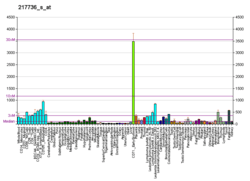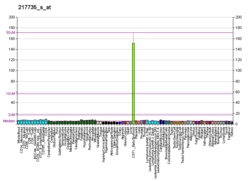EIF2AK1
Eukaryotic translation initiation factor 2-alpha kinase 1 is an enzyme that in humans is encoded by the EIF2AK1 gene.[5][6][7]
Function
EIF2AK1 inhibits protein synthesis at the translation initiation level, in response to various stress conditions, including oxidative stress, heme deficiency, osmotic shock and heat shock. EIF2AK1 exerts its function through the phosphorylation of EIF2S1 at 'Ser-48' and 'Ser-51', thus preventing its recycling. Binds hemin forming a 1:1 complex through a cysteine thiolate and histidine nitrogenous coordination. This binding occurs with moderate affinity, allowing it to sense the heme concentration within the cell. Owing to this unique heme-sensing capacity, it plays a crucial role in shutting off protein synthesis during acute heme-deficient conditions. In red blood cells (RBCs), it controls hemoglobin synthesis ensuring a coordinated regulation of the synthesis of the heme and globin moieties of hemoglobin. Thus plays an essential protective role for RBC survival in anemias of iron deficiency. Similarly, in hepatocytes, involved in heme-mediated translational control of CYP2B and CYP3A and possibly other hepatic P450 cytochromes. EIF2AK1 also act to moderate ER stress during acute heme-deficient conditions.
Enzymology
EIF2AK1 is a kinase, thus it catalyses the following reaction:
ATP + a protein = ADP + a phosphoprotein
EIF2AK1 is induced by acute heme depletion, that not only increases EIF2AK1 protein levels, but also stimulates kinase activity by autophosphorylation. Inhibited by the heme-degradation products biliverdin and bilirubin. Induced by oxidative stress generated by arsenite treatment. Binding of nitric oxide (NO) to the heme iron in the N-terminal heme-binding domain activates the kinase activity, while binding of carbon monoxide (CO) suppresses kinase activity.
cite:https://www.uniprot.org/uniprot/Q9BQI3 The HRI gene is localized to 7p22 where its 3' end slightly overlaps the 3' end of the gene JTV1. The two genes are transcribed from opposite strands. Studies in rat and rabbit suggest that the HRI gene product phosphorylates the alpha subunit of eukaryotic initiation factor 2. Its kinase activity is induced by low levels of heme and inhibited by the presence of heme.[7]
References
- 1 2 3 GRCh38: Ensembl release 89: ENSG00000086232 - Ensembl, May 2017
- 1 2 3 GRCm38: Ensembl release 89: ENSMUSG00000029613 - Ensembl, May 2017
- ↑ "Human PubMed Reference:".
- ↑ "Mouse PubMed Reference:".
- ↑ Chen JJ, London IM (May 1995). "Regulation of protein synthesis by heme-regulated eIF-2 alpha kinase". Trends Biochem Sci. 20 (3): 105–8. doi:10.1016/S0968-0004(00)88975-6. PMID 7709427.
- ↑ Nagase T, Kikuno R, Ishikawa KI, Hirosawa M, Ohara O (Apr 2000). "Prediction of the coding sequences of unidentified human genes. XVI. The complete sequences of 150 new cDNA clones from brain which code for large proteins in vitro". DNA Res. 7 (1): 65–73. doi:10.1093/dnares/7.1.65. PMID 10718198.
- 1 2 "Entrez Gene: EIF2AK1 eukaryotic translation initiation factor 2-alpha kinase 1".
Further reading
- Hu RM, Han ZG, Song HD, et al. (2000). "Gene expression profiling in the human hypothalamus-pituitary-adrenal axis and full-length cDNA cloning". Proc. Natl. Acad. Sci. U.S.A. 97 (17): 9543–8. doi:10.1073/pnas.160270997. PMC 16901. PMID 10931946.
- Shao J, Grammatikakis N, Scroggins BT, et al. (2001). "Hsp90 regulates p50(cdc37) function during the biogenesis of the activeconformation of the heme-regulated eIF2 alpha kinase". J. Biol. Chem. 276 (1): 206–14. doi:10.1074/jbc.M007583200. PMID 11036079.
- Hartley JL, Temple GF, Brasch MA (2001). "DNA cloning using in vitro site-specific recombination". Genome Res. 10 (11): 1788–95. doi:10.1101/gr.143000. PMC 310948. PMID 11076863.
- Hwang SY, Kim MK, Kim JC (2001). "Cloning of hHRI, human heme-regulated eukaryotic initiation factor 2alpha kinase: down-regulated in epithelial ovarian cancers". Mol. Cells. 10 (5): 584–91. doi:10.1007/s10059-000-0584-5. PMID 11101152.
- Wiemann S, Weil B, Wellenreuther R, et al. (2001). "Toward a catalog of human genes and proteins: sequencing and analysis of 500 novel complete protein coding human cDNAs". Genome Res. 11 (3): 422–35. doi:10.1101/gr.GR1547R. PMC 311072. PMID 11230166.
- Simpson JC, Wellenreuther R, Poustka A, et al. (2001). "Systematic subcellular localization of novel proteins identified by large-scale cDNA sequencing". EMBO Rep. 1 (3): 287–92. doi:10.1093/embo-reports/kvd058. PMC 1083732. PMID 11256614.
- Anand S, Pal JK (2003). "The haem-regulated eukaryotic initiation factor 2alpha kinase: a molecular indicator of lead-toxicity anaemia in rabbits". Biotechnol. Appl. Biochem. 36 (Pt 1): 57–62. doi:10.1042/BA20020009. PMID 12149123.
- Omasa T, Chen YG, Mantalaris A, et al. (2003). "Molecular cloning and sequencing of the human heme-regulated eukaryotic initiation factor 2 alpha (eIF-2 alpha) kinase from bone marrow culture". DNA Seq. 13 (3): 133–7. doi:10.1080/10425170290023428. PMID 12391722.
- Strausberg RL, Feingold EA, Grouse LH, et al. (2003). "Generation and initial analysis of more than 15,000 full-length human and mouse cDNA sequences". Proc. Natl. Acad. Sci. U.S.A. 99 (26): 16899–903. doi:10.1073/pnas.242603899. PMC 139241. PMID 12477932.
- Scherer SW, Cheung J, MacDonald JR, et al. (2003). "Human chromosome 7: DNA sequence and biology". Science. 300 (5620): 767–72. doi:10.1126/science.1083423. PMC 2882961. PMID 12690205.
- Rafie-Kolpin M, Han AP, Chen JJ (2003). "Autophosphorylation of threonine 485 in the activation loop is essential for attaining eIF2alpha kinase activity of HRI". Biochemistry. 42 (21): 6536–44. doi:10.1021/bi034005v. PMID 12767237.
- Hillier LW, Fulton RS, Fulton LA, et al. (2003). "The DNA sequence of human chromosome 7". Nature. 424 (6945): 157–64. doi:10.1038/nature01782. PMID 12853948.
- Ota T, Suzuki Y, Nishikawa T, et al. (2004). "Complete sequencing and characterization of 21,243 full-length human cDNAs". Nat. Genet. 36 (1): 40–5. doi:10.1038/ng1285. PMID 14702039.
- Gerhard DS, Wagner L, Feingold EA, et al. (2004). "The status, quality, and expansion of the NIH full-length cDNA project: the Mammalian Gene Collection (MGC)". Genome Res. 14 (10B): 2121–7. doi:10.1101/gr.2596504. PMC 528928. PMID 15489334.
- Wiemann S, Arlt D, Huber W, et al. (2004). "From ORFeome to biology: a functional genomics pipeline". Genome Res. 14 (10B): 2136–44. doi:10.1101/gr.2576704. PMC 528930. PMID 15489336.
- Mehrle A, Rosenfelder H, Schupp I, et al. (2006). "The LIFEdb database in 2006". Nucleic Acids Res. 34 (Database issue): D415–8. doi:10.1093/nar/gkj139. PMC 1347501. PMID 16381901.
- Olsen JV, Blagoev B, Gnad F, et al. (2006). "Global, in vivo, and site-specific phosphorylation dynamics in signaling networks". Cell. 127 (3): 635–48. doi:10.1016/j.cell.2006.09.026. PMID 17081983.





